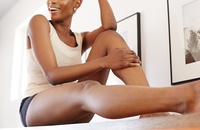GROUPON GUIDE TO RALEIGH-DURHAM
What Is Cellulite, and Can You Get Rid of It?
BY: Editors |Jun 18, 2019
Deals on Cellulite Treatments

Endermologie Sessions for Smoother Skin and Cellulite Reduction
2206 Page rd suite 204, Durham
Sale Ends 4/23
$56.13 with_code GROUPON
J Marees Total Body Studio

Get Fuller Lips with Non-Invasive Lip Fillers Treatment
810 E Chatham street, Cary
Sale Ends 4/23
$153.09 with_code GROUPON
M&S Spa and Salon

Firmer skin with One, Three, or Six Lipo Fat Reduction Treatment
1921 North Pointe Drive, Durham
Sale Ends 4/23
$40.09 with_code GROUPON
Sweet Silhouette Body Contouring Boutique LLC

Experience Infrared Weight Loss Tunnel Treatments
584 Executive Place, Fayetteville
Sale Ends 4/23
$185.49 with_code GROUPON
Claudia's Nails & Spa

Boost Your Wellness with One or Three Rejuvenating Sauna Wrap Sessions
5684 U.S. 70, Goldsboro • 48.7 mi
Sale Ends 4/23
$36.45 with_code GROUPON
Body Contour

Trending
Relax with an Ionic Detox Foot Bath Experience
2206 Page rd suite 204, Durham
Sale Ends 4/23
$34.83 with_code GROUPON
J Marees Total Body Studio

1, 2, or 3 Sessions of 30 Minutes of Ultrasound Cavitation and RF
7520 Ramble Way, Raleigh
Sale Ends 4/23
$34.83 with_code GROUPON
1 bought
Brow Catching LLC

Up to 21% Off on Sauna Weight Loss Treatment at BodyVio
1017 North Central Expressway, Plano
Sale Ends 4/23
$89.10 with_code GROUPON
BodyVio

Up to 40% Off on Fat Reduction - Non-Branded at Infinite30 Weight Loss & Wellness
2340 Bale Street, Raleigh
40% discount_off
$479.52 with_code GROUPON
1 bought
Infinite30 Weight Loss & Wellness

Up to 72% Off on Cavitation at Tax Lien Property Investments Seminar
Sale Ends 4/23
$45.20 with_code GROUPON
Peach Academy

Achieve Your Body Goals with Ultrasonic Sculpting Sessions
143 West 29th Street, New York
Sale Ends 4/23
$124.74 with_code GROUPON
M Beauty Studio Spa

Up to 50% Off on Velashape at The girl spot spa aesthetic
473 Northeast 20th Street, Boca Raton
50% discount_off
$216 with_code GROUPON
The girl spot spa aesthetic

Up to 61% Off on Fat Freezing and Fat Reduction
143 West 29th Street, New York
Sale Ends 4/23
$177.39 with_code GROUPON
M Beauty Studio Spa
More Cellulite Treatments

Trending
Laser Lipo or Cavitation Treatments for Body Contouring
2206 Page rd suite 204, Durham
Sale Ends 4/23
$39.69 with_code GROUPON
J. Maree's Total Body Studio

Transform your body with nine, six, or three cavitation treatments
1133 Military Cutoff Road, Wilmington
Sale Ends 4/23
$122.31 with_code GROUPON
Pure Cosmetics of Wilmington

Trending
Transform Your Body with Tailored Cavitation Sessions
3801 Computer Drive, Raleigh
Sale Ends 4/23
$81.81 with_code GROUPON
Fifty Shades Of Body

Transform Your Body with 3 or 6 Sessions of Cellulite Reduction
5684 U.S. 70, Goldsboro • 48.7 mi
Sale Ends 4/23
$112.59 with_code GROUPON
1 bought
Body Contour

Choose from 3, 6, or 9 Lipo-Cavitation Treatments for Body Contouring
2840 Plaza Place, Raleigh
85% discount_off
Pure Cosmetics of Raleigh

Revitalize Skin with Ultra-Lift Skin Tightening Sessions
1501 North Highway 17, Room 105 Phenix Salons (Suite J), Mount Pleasant
Sale Ends 4/23
$39.69 with_code GROUPON
GoodBye BodyFat

Six or Three Non Surgical Laser Lipo Cavitation Treatments
3801 Computer Drive, Raleigh
Sale Ends 4/23
$83.83 with_code GROUPON
Fifty Shades Of Body

Non Invasive Fat Cavitation Therapy Sessions for Body Contouring
1133 Military Cutoff Road, Wilmington
Sale Ends 4/23
$49.01 with_code GROUPON
Pure Cosmetics of Wilmington

Up to 73% Off on Cavitation at The Beautyhub Wellness Spa,LLC
5300 Atlantic Avenue, Raleigh
Sale Ends 4/23
$48.60 with_code GROUPON
The Beautyhub Wellness Spa,LLC

Up to 37% Off on Sauna Weight Loss Treatment at Contouring Body Bar LLC
5611 North Carolina 55, Durham
Sale Ends 4/23
$28.35 with_code GROUPON
Contouring Body Bar LLC

Body Fat Reduction on Abdomen and Thighs with VanquishME
251 Keisler Drive, Cary
Sale Ends 4/23
$607.50 with_code GROUPON
Avail Aesthetics

Up to 55% Off on Therapeutic Massage at M Beauty Studio Spa
143 West 29th Street, New York
Sale Ends 4/23
$92.34 with_code GROUPON
M Beauty Studio Spa

Detox & Tighten with CelluTherm Sauna Sessions with Cellulite Wrap
1921 North Pointe Drive, Durham
Sale Ends 4/23
$40.50 with_code GROUPON
1 bought
Sweet Silhouette Body Contouring Boutique

Choose From Body Sculpting, Cavitation or Lipolaser Sessions
807 Spring Forest Rd., Raleigh
Sale Ends 4/23
$68.04 with_code GROUPON
GiGi Aesthetics

Up to 82% Off on Ultrasonic Fat Reduction at Cryo Lab
7361 Six Forks Rd, Raleigh
Sale Ends 4/23
$89.10 with_code GROUPON
Cryo Lab Face + Body - Raleigh







